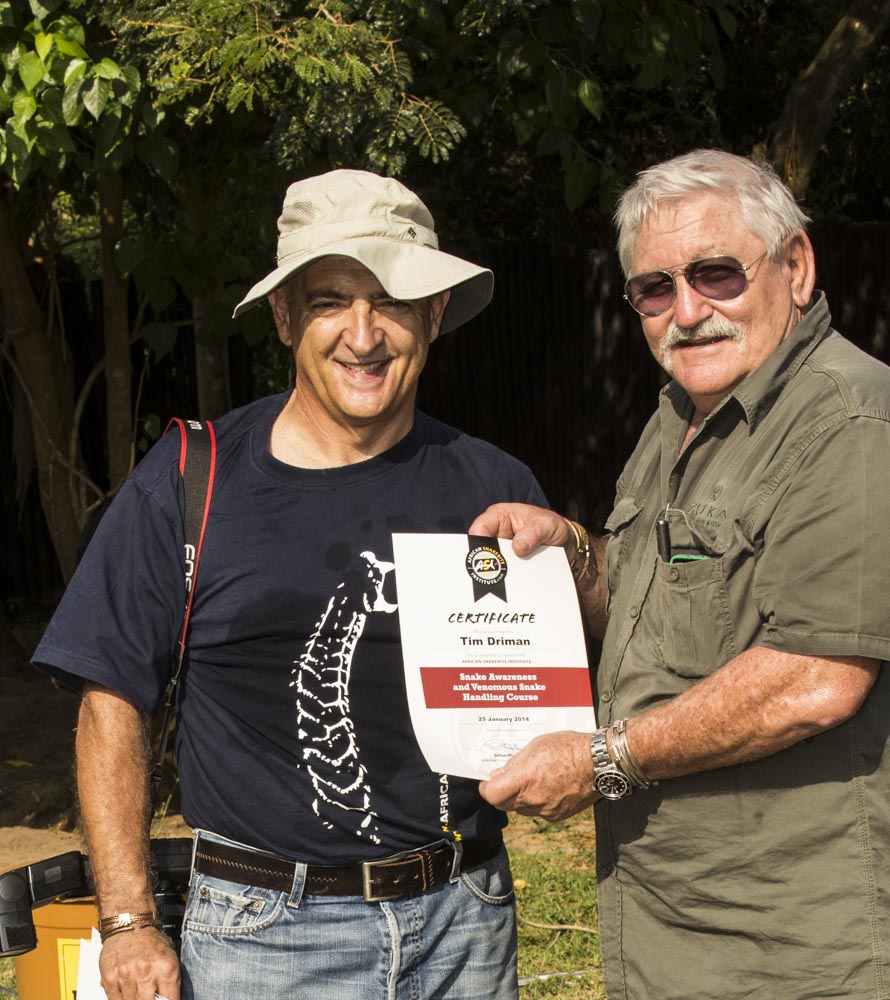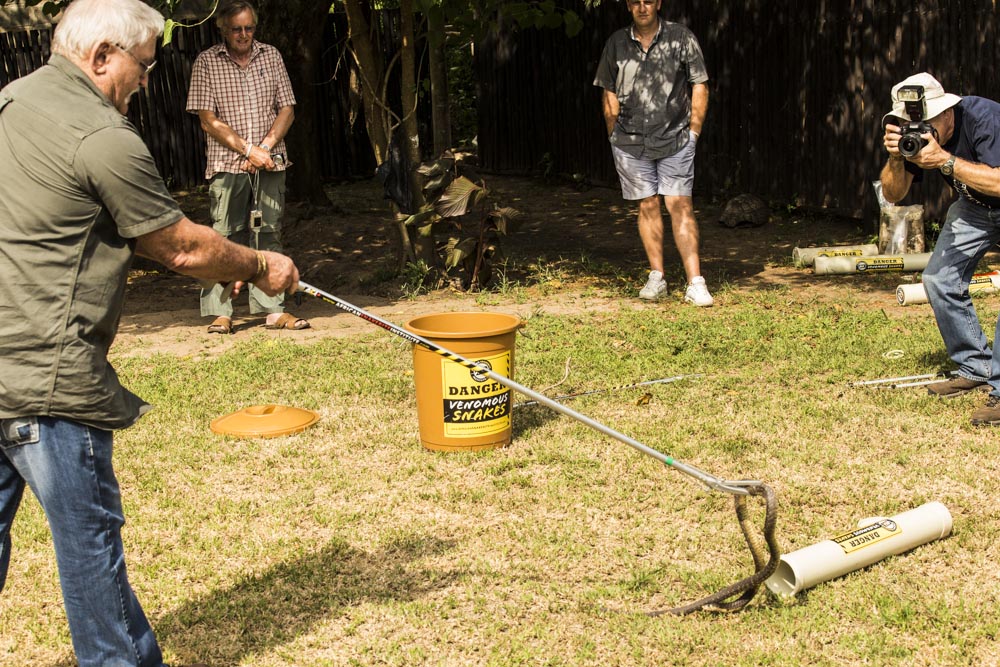There are 169 different species of snakes in southern Africa – of which, 96 are considered venomous, and of those 96, only 18 species are considered deadly.
Even though the term “deadly” sounds scary, it doesn’t necessarily mean that once you get envenomated (aka bitten) that you will die immediately. Not all venoms have the same effect on all victims. What may be deadly for a mouse, may present no more than swelling, a headache and/or discomfort for a human being. Again, that also depends on the amount of venom that has been injected into the victim. Most snakes are able to control their flow of venom and usually will administer just enough to do the job which they intend. Sometimes they don’t release any venom at all, resulting in a dry bite.
It is NOT necessary to identify the snake that bites the victim. Should a person suffer a snakebite, you should always assume that venom has been released, and it is most important to check the symptoms resulting from the envenomation.

Tim receiving his certificate from Johan Marais, for completing Johan’s training, “Snake Awareness and Venomous Snake Handling Course”. Please learn more about Johan, his training courses and his books here: www.johanmarais.co.za and www.africansnakebiteinstitute.com.
In the event of a snakebite… DO NOT try to kill the snake.
A second bite would complicate matters…
Snakebite victims are treated according to the symptoms that they display so, while it would be handy to have a positive identification, it is not necessary.
1. Expose the Wound Area
Cut away any clothing around the actual wound, remove rings, watches, shoes etc., and gently wipe away any excess venom and moisture, which may be around the wound area. (Do not do this with your hand! Do it with a cloth or some piece of clothing to avoid possible contamination of any open cuts or wounds on your own hand.)
2. DO NOT Squeeze the Wound Area
Nor try to administer any chemical such as Condy’s crystals (potassium permanganate). DO NOT apply any suction by mouth. It MAY be acceptable to use suitable vacuuming equipment, even though this would only be used to help calm the victim. This would actually be wasting time that could be better used with more positive treatment. (Suction has no benefit and often causes tissue damage.)
3. Maintain the Airway
Ensure that the patient has a clear airway and can breathe freely. Neurotoxic envenomation (Mambas, Cape Cobras, Forest Cobras*, Snouted Cobras* and Rinkhals*) affects the nervous system, resulting in pain at the point of snakebite; minimal / no swelling; drowsiness, vomiting; blurred vision; profuse sweating, difficulty in swallowing and breathing, within 30 minutes to several hours. This leads to gradual muscle paralysis and ultimate respiratory failure, which is what actually kills the patient!
*Forest Cobras, Rinkhals and, to some degree, Snouted Cobras have as much, or more, cytotoxin in their venom than neurotoxins.
4. Keep the patient warm, calm and as still as possible.
DO NOT administer alcohol, a sedative or any shock treatment. It is important to keep the victim awake!
5. Immobilise the Limb
Venom into a vein or artery is largely a myth. The blood system is NOT the way venom finds its way around a body. Venom moves via the body’s lymphatic system, so immobilise the limb using a splint, and keep the limb below the heart level of the victim. If it is a cytotoxic bite, rather elevate the limb as it will be extremely painful if it is below the heart.
(Traditional thinking prescribed binding a tourniquet above the snakebite location in order to stem the movement of blood carrying the venom – do not do this. People also used to make incisions on either side of the punctured area and suck out the venom – this is also totally incorrect – DON’T do this either!)
6. Call for Help
While you apply the above, someone else should call around to establish the closest hospital that HAS A TRAUMA UNIT. More often than not, a hospital without a specific trauma unit will not have staff or equipment that could help, thereby wasting precious time.
7. Evacuate the Victim
Once you have established the location of the nearest hospital with a trauma unit, make contact with them and advise them of the symptoms which the victim displays and get them to that hospital without any further delay.
8. Anti-Venom
Unless there is a properly qualified doctor available with the correct anti-venom, it is advisable NOT to attempt to administer such treatment if you are not suitably trained.

General Comment
Most snakes are not interested in confrontation and will move off when hearing or feeling the vibration of someone approaching. But, if a snake is cornered with no escape option, it will defend itself, either by striking at the very last moment, or spraying or squirting venom (snakes do not spit). Cobras and Rinkhals are most likely to do this.
In the event of being sprayed in the eye/s by a cobra or Rinkhals, you should immediately wash the eye/s with fresh, cool water for no less than fifteen (15) minutes. Milk is NOT advisable, but in the absence of fresh, cool water, other clean, humanly consumable liquids can be used. As a last resort, human urine can also be used.
The adder family, usually identified by their beautiful, diamond-shaped patterns and markings, are extremely well camouflaged and tend to keep perfectly still when approached. Often they won’t even strike until trodden on.
No snake is capable of striking further than its own body length and, while some snakes can rear up, this is usually no more than about a third of its body length. Stories of snakes (eg: Black Mamba) standing on their tails and staring a man in the eyes are myths – it’s not physically possible.
Snakes are more active after rain.
Baby snakes are just as venomous as fully grown snakes.
Be safe and treat all snakes as potentially dangerous.
If you are confronted by a snake and you have no way of retreating, STAND DEAD STILL, even if it is coming towards you.
It is NOT coming to hurt you. It is simply headed to a safe area of its choice and could even crawl over your foot to get there, but it will not harm you, as long as you stand ABSOLUTELY STILL and do not startle it!
If you find a snake in your room and have no way of removing it yourself, simply close the door and call someone who can remove it safely.
NEVER kill any snake. We live with snakes all around us and by removing one, you may be opening up a new territory for another to take its place.